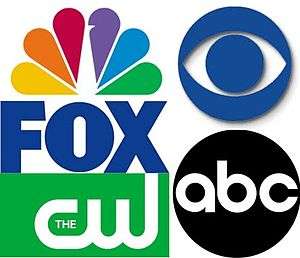Broadcast network

A broadcast network is an organization, such as a corporation or voluntary association, that provides live or recorded content (such as movies, newscasts, sports, public affairs programming, and other programs) for broadcast over a group of radio or television stations. Most networks are primarily either a television network or a radio network, although some organizations run both types of networks.
Streaming media, Internet radio, and webcasting are sometimes considered forms of broadcasting despite the lack of broadcast stations; in which case its practitioners may also be called "broadcasters" or even "broadcast networks".
History
American Networks
Reginald Fessenden, a former engineer and communications researcher for the U.S. Weather Bureau was the first individual to transmit a regular radio broadcast. His broadcasts were to ships at sea, for which he used radio telegraphy equipment. His programs consisted of a recorded Handel piece, a violin performance, and a reading from the Bible. He claimed to be the first to transmit the human voice. General Electric was encouraged years later to create the Radio Corporation of America (RCA). Around this time, AT&T also became involved in radio.[1]
AT&T
With all of these stations going on the air, AT&T devised the concept of sharing programming to save on effort required to create programming. In addition, programs sometimes appealed to the audiences of more than one station. When two or three stations link together from a telephone line it is called chain broadcasting. Since the phone lines were owned by AT&T, they were the first corporation to begin the sharing of two or three stations via telephone lines.
In 1924, the Eveready Hour was broadcast over 12 stations, many of them owned by AT&T. Eveready Hour was the first commercially sponsored variety show in the history of broadcasting. National companies were able to reach large portions of the nation with their brand names and slogans in a resourceful manner. By 1925 AT&T had linked together 26 stations in a network. They also ran an owned & operated (O&O) station, WEAFNinew York.[2]
RCA
Radio Corporation of America (RCA) followed suit, using AT&T’s network model. However, conflict resulted as RCA needed to lease phone lines from AT&T. The Federal Trade Commission (FTC) took notice of this and charged AT&T with United States antitrust law violations. In 1926 AT&T sold off their broadcasting interests to RCA. RCA agreed to lease network connections from AT&T and for several decades AT&T made a profitable business in radio and television networking.[3]
NBC
In 1926, RCA created the National Broadcasting Company (NBC) under David Sarnoff. When NBC first launched, it comprised two groups of stations that worked together, with different programs and sponsors to support. The two networks were called NBC Red and NBC Blue. NBC Red covered stronger stations and NBC Blue covered weaker stations.[4]
In 1941, the Federal Communications Commission (FCC) issued the Report on Chain Broadcasting, an investigation into the monopolistic practices of the radio networks. The FCC cited NBC Red and NBC Blue as a primary concern, which the commission thought was anti-competitive. Since the FCC does not have the power to regulate the networks, they decided aim the regulations to the stations. In 1943, the Supreme Court of the United States took away the FCC’s power to enforce chain broadcasting regulations. NBC Blue was sold to Edward Noble who later named it the American Broadcasting Company (ABC).[5] NBC also had a chain of shortwave stations, called NBC White Network, in the 1930s.
CBS
During 1926 and 1927 home radios were increasing dramatically in popularity. The third radio network that came about was the Columbia Broadcasting System (CBS). William S. Paley bought Columbia. CBS struggled at first because both NBC networks had a head start. Paley helped out CBS to get them where NBC was. Under Paley's leadership, CBS focused on entertainment programming, news, and news affiliation. Regional networks on CBS also existed in various parts of the country.[6] CBS later hired Edward R. Murrow who is credited with boosting ratings dramatically. Murrow and CBS covered the war in Europe while Adolf Hitler was in power. NBC and ABC withdrew from the war for safety reasons. As a result of taking the risk, CBS's ratings skyrocketed.[7]
ABC
NBC Blue was sold to Edward Noble, and became the American Broadcasting Company (ABC). ABC was born due to the controversy that the FCC had with NBC Blue and NBC Red. By the mid-1940s the broadcasting arena was a big Three television networks battle. Noble’s network almost went bankrupt and in 1951 Leonard Goldenson and United Paramount Theaters bought ABC for $25 million. In 1964, ABC won the ratings race in the fifty largest U.S markets. In the 1970–71 season, ABC ranked #1 in the Nielsen ratings with a medical drama called Marcus Welby, M.D.,[8] the first ABC television show to top the list.
Canadian National Networks
CBC
Canadian Broadcasting Corporation
CTV
Global
References
- ↑ Aaron. (2010). The History of Radio: Birth of Network. "Archived copy". Archived from the original on 2012-07-27. Retrieved 2011-05-04.
- ↑ Perry, S. D. (2004). A Consolidated History of Media. Epistelogic Publishing: Bloomington, IL.
- ↑ Perry, S. D. (2004). A Consolidated History of Media. Epistelogic Publishing: Bloomington, IL.
- ↑ Perry, S. D. (2004). A Consolidated History of Media. Epistelogic Publishing: Bloomington, IL.
- ↑ Rivera-Sanchez, M. (1998). Report on Chain Broadcasting. History of the Mass Media in the United States, An Encyclopedia, pg 590-591.
- ↑ Perry, S. D. (2004). A Consolidated History of Media. Epistelogic Publishing: Bloomington, IL.
- ↑ Edwards, B. (2004). Edward R. Murrow and the Birth of Broadcast Journalism. New Jersey: Navta Associates, Inc.
- ↑ (2011). American Broadcasting Company. The Museum of Broadcast Communications. http://www.museum.tv/eotvsection.php?entrycode=americanbroa